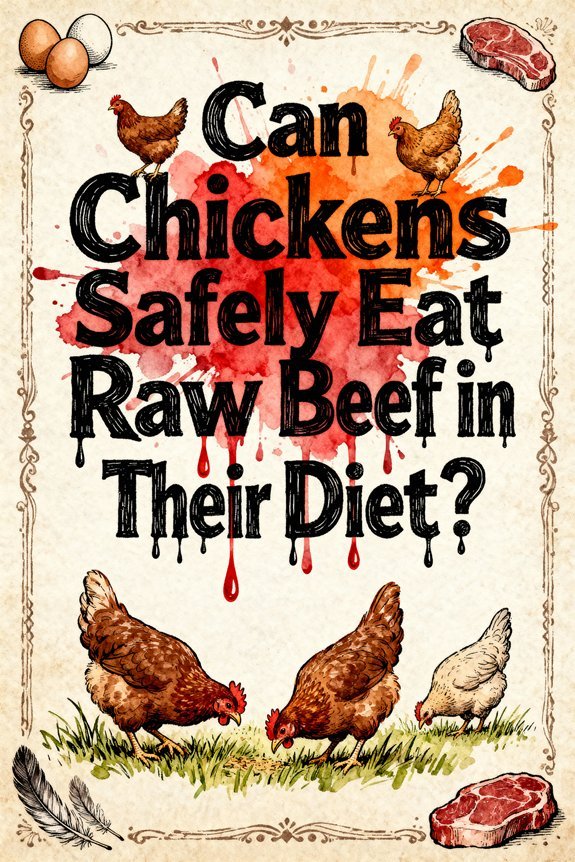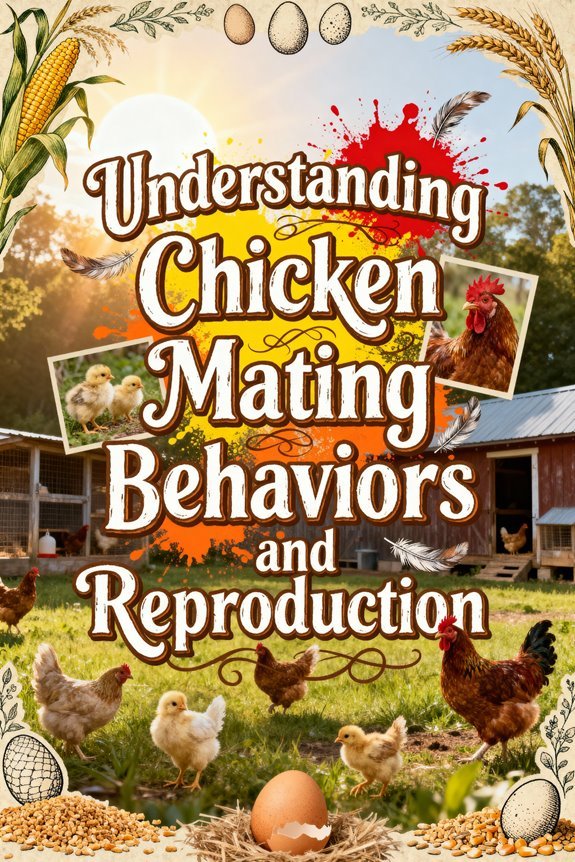Can Chickens Safely Eat Raw Beef in Their Diet?
While chickens can physically eat raw beef, you shouldn’t feed it to them due to significant health and safety concerns. Raw beef can expose your flock to dangerous pathogens like Salmonella, E. coli, and Listeria, potentially causing severe illness. Many jurisdictions also legally prohibit feeding meat to poultry. Instead, focus on natural protein sources like insects, seeds, and commercial feeds that match chickens’ digestive capabilities. Understanding safe alternatives will help protect your flock’s health.
Legal Regulations Around Feeding Raw Beef to Chickens
While federal regulations in the United States don’t explicitly prohibit feeding raw beef to backyard chickens, a complex web of state and international laws creates considerable legal considerations for poultry owners. You’ll find the regulatory landscape varies considerably by jurisdiction, with some states strictly banning meat-containing food waste in poultry feeding, particularly for commercial operations. International policies, especially in Canada and Australia, explicitly prohibit feeding meat and meat by-products to poultry to prevent disease transmission.
Though backyard chicken owners face fewer restrictions than commercial operations, you’re still responsible for following food safety protocols and disease prevention measures. The USDA and FDA overlap in their oversight of poultry feeding practices, focusing primarily on preventing the spread of pathogens and diseases like Mad Cow Disease through feed control. These regulations help prevent biosecurity risks that could devastate farming communities through widespread disease outbreaks.
Understanding the Natural Diet of Chickens
Although chickens are often viewed as simple grain-eaters, their natural diet encompasses a complex mix of plant and animal proteins important for ideal health. You’ll find their dietary preferences include seeds, grains, insects, and small invertebrates, with protein requirements ranging from 15-20% depending on their life stage.
Through natural foraging behavior, chickens actively seek diverse nutrient sources. Their omnivorous digestive system efficiently processes both plant and animal matter, while their gizzard breaks down harder food items. Before starting a backyard flock, check your area’s local zoning laws regarding permitted chicken numbers and coop requirements. Chickens need a specially developed methionine-rich diet for optimal health since it’s the most limiting amino acid in poultry nutrition. They’ll consume carbohydrates primarily from grains (60-75% of diet), essential fats from insects and seeds, and critical minerals like calcium from insect exoskeletons. This varied diet supports significant functions including growth, egg production, immune health, and proper nutrient absorption.
Health Risks of Raw Beef Consumption
Despite chicken’s omnivorous nature, feeding them raw beef introduces serious health risks that can compromise their wellbeing and survival. Raw beef toxicity can manifest through pathogens like Salmonella, E. coli, and Listeria, potentially causing fatal infections in your flock. These bacteria are particularly dangerous because they can lead to severe symptoms including bloody diarrhea, sepsis, and kidney failure. Ground beef presents an even higher risk due to its mixed origins and increased surface area for bacterial growth.
Your chickens will also face digestive challenges when consuming raw beef, as their digestive tract isn’t designed to process uncooked mammalian protein efficiently. Their shorter, more acidic digestive system, which evolved to handle grains and insects, struggles with raw beef’s compounds. This can result in nutrient malabsorption and chronic digestive upset, ultimately stressing their gut health and increasing their vulnerability to diseases.
Bacterial and Pathogen Concerns
Raw beef harbors numerous dangerous pathogens that pose significant health risks to your chickens, including *Salmonella*, *E. coli*, *Listeria monocytogenes*, and *Campylobacter*. These bacteria can survive in your chickens’ gastrointestinal tract and replicate, leading to both symptomatic and asymptomatic infections.
Bacterial transmission occurs through multiple pathways when raw beef is present in your chicken’s environment. Cross-contamination can happen through shared cutting boards, utensils, or storage spaces. The bacteria may persist in feed, water sources, and housing areas, creating ongoing exposure risks. Your chickens can then shed these pathogens in their feces, contaminating the environment and potentially infecting other flock members. While some bacteria like *Salmonella* readily colonize chicken intestines, others such as *Listeria* may survive without extensive replication. Studies show that store-bought meat frequently contains harmful bacteria, with approximately 24% of samples testing positive for dangerous pathogens.
Nutritional Benefits and Drawbacks
When considering the nutritional profile of beef for your chickens, several key benefits and limitations emerge from its macronutrient composition. Raw beef’s high protein absorption supports growth efficiency and muscle development, while its mineral availability, particularly iron and zinc, enhances immune support. The fat composition provides substantial energy capacity, though you’ll need to monitor intake to prevent excessive weight gain. Much like lean protein in chicken, beef offers essential amino acids for muscle building.
While beef delivers essential vitamin content, including B-complex vitamins vital for metabolic effects, it can’t serve as a complete feed. You’ll find significant gaps in nutrient balance, particularly in fiber and calcium. These limitations can impact your chickens’ digestive health and bone development. To maximize benefits, you should incorporate raw beef as part of a diverse diet rather than a primary food source.
Safe Feeding Practices and Portions
Although feeding raw beef to chickens may seem nutritionally beneficial, strict legal restrictions in many countries prohibit this practice due to disease transmission risks. If you’re in a jurisdiction where it’s permitted, you’ll need to follow specific portion control and feeding frequency guidelines to maintain flock health.
Limit raw beef to 2 tablespoons per bird daily, offering it intermittently rather than continuously throughout the week. You’ll need to maintain strict hygiene protocols, including thorough cleaning of feeding containers and prompt removal of uneaten meat. Ascertain your birds have adequate space and supplemental grit for proper digestion. Never feed processed meats, seasoned products, or spoiled meat, as these can harm your flock. Always wash your hands, utensils, and surfaces after handling raw beef to prevent cross-contamination. Adult chickens need 17% protein during the laying period, which can be obtained through commercial feeds rather than raw meat sources.
Impact on Chicken Behavior
Introducing raw beef into your chickens’ diet can trigger considerable behavioral changes that warrant careful observation. You’ll likely notice increased foraging activity and enthusiasm, as meat consumption aligns with their natural omnivorous instincts, providing behavioral enrichment. While raw beef doesn’t directly disrupt social dynamics or pecking order, improper management of feeding spaces could indirectly contribute to flock stress. Maintaining proper cleaning schedules is essential when offering raw beef to prevent contamination and illness-related behavioral issues.
Monitor your birds for signs of temporary stress during dietary changes, but don’t automatically attribute behavioral alterations to meat consumption. Most aggressive or cannibalistic behaviors stem from social hierarchy issues rather than diet. If you’re introducing raw beef, guarantee adequate space and environmental enrichment, as these factors impact flock harmony more greatly than dietary meat inclusion. Proper portion control remains essential to prevent obesity-related mobility issues.
Alternative Protein Sources for Chickens
Chicken owners seeking alternatives to raw beef have numerous protein-rich options available for their flocks. Plant-based sources like soybean meal deliver essential amino acids, while canola meal provides 36-39% crude protein that effectively complements soybean meal in meeting sulfur amino acid requirements. For an economical option, dried lentils offer 9 grams of protein per 100 grams and are easy to prepare for chickens. Molasses treats provide a nutritious and engaging protein supplement that keeps chickens entertained while foraging. Dried mealworms make an excellent protein supplement during molting seasons when chickens need extra nutrients for feather regrowth.
Insect proteins present a particularly promising alternative, offering crude protein levels of 48-65% – considerably higher than most plant sources. Crickets, grasshoppers, and locusts not only supply essential amino acids like lysine and methionine but also contain beneficial bioactive compounds that may enhance poultry health. These insect-derived proteins demonstrate digestibility rates comparable to or better than traditional protein sources like fishmeal and soybean meal, making them an efficient and sustainable option for your flock’s dietary needs.
Best Practices for Meat Handling and Storage
Safe meat handling practices form the foundation of preventing foodborne illness when feeding raw beef to chickens. You’ll need to maintain strict temperature control by keeping raw beef at or below 41°F (5°C) during meat storage and transportation. Use sealed, leak-proof containers to prevent cross contamination with other feeds and surfaces.
Always wash your hands with soap and warm water for at least 20 seconds before and after handling raw beef. Use dedicated cutting boards and utensils for raw meat preparation, and clean all surfaces thoroughly with hot, soapy water afterward. Watch carefully for signs of spoilage like sticky or slimy texture which indicates the meat has gone bad. Store raw beef separately from other feeds in your refrigerator, and discard any meat that’s been left at room temperature for over two hours. When in doubt about the safety or freshness of stored meat, throw it out.




